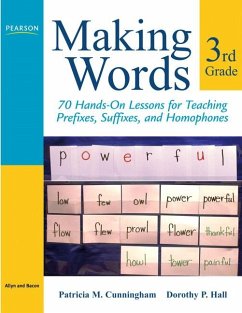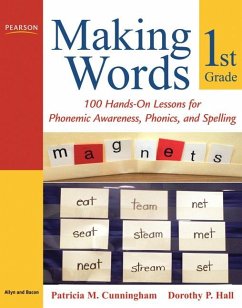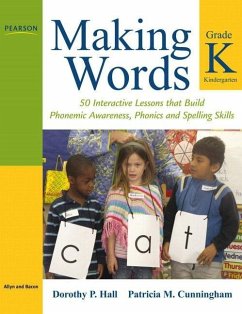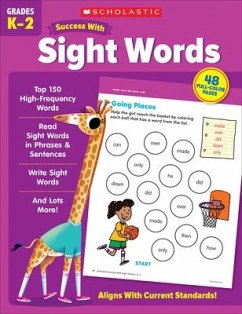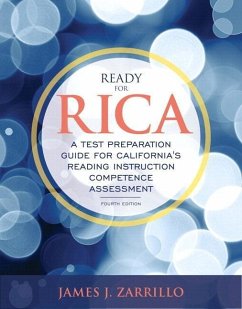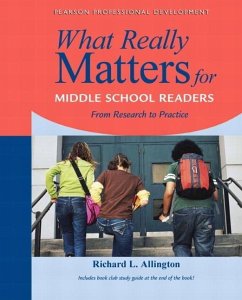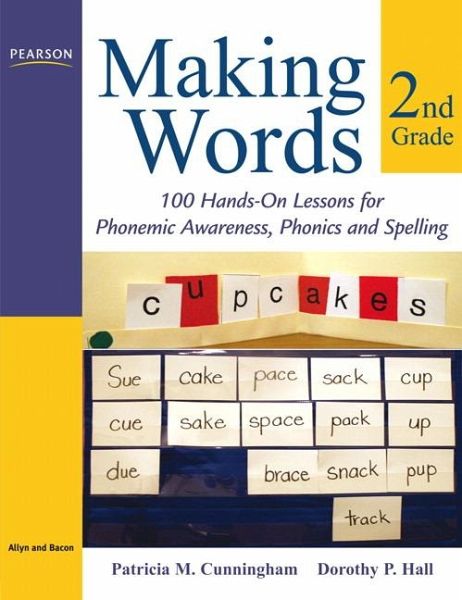
Making Words Second Grade
100 Hands-On Lessons for Phonemic Awareness, Phonics and Spelling
Versandkostenfrei!
Versandfertig in über 4 Wochen
58,99 €
inkl. MwSt.

PAYBACK Punkte
29 °P sammeln!
An active and innovative approach to making words that teachers and their students have grown to love is finally here!
Based on its highly successful parent text, Phonics They Use, this new grade-level series Making Words offers teachers a fresh multi-level activity and lesson series written for the kindergarten through fifth grade classroom. Pat Cunningham and Dottie Hall present classroom teachers with effective tools for strengthening phonics and spelling skills that encourage students to move beyond learning and into a world of word discovery. Each research-based volume includes a wealth of friendly, hands-on, manipulative activities that guide teachers in teaching the development of words--from phonemic awareness to spelling.
In Making Words Second Grade, Pat and Dottie introduce second grade teachers to 100 lessons that teach all the phonics, spelling, and phonemic awareness skills included in most second grade curricula. Each Making Words activity leads children through a systematic and sequential phonics curriculum. All lessons include practice with the phonemic awareness skills of segmenting and blending as children stretch out words they are making and blend the letters to make new words. Because teaching children letter-sound relationships is easier than teaching children to actually use these letter-sound relationships, all lessons include a transfer step in which children apply the sounds they are learning to spelling new words.
Making Words Second Grade is the best resource you can have on hand for motivating your students to learn words!
Product Description
An active and innovative approach to making words that teachers and their students have grown to love is finally here!
Based on its highly successful parent text, Phonics They Use, this new grade-level series Making Words offers teachers a fresh multi-level activity and lesson series written for the kindergarten through fifth grade classroom. Pat Cunningham and Dottie Hall present classroom teachers with effective tools for strengthening phonics and spelling skills that encourage students to move beyond learning and into a world of word discovery. Each research-based volume includes a wealth of friendly, hands-on, manipulative activities that guide teachers in teaching the development of words--from phonemic awareness to spelling.
In Making Words Second Grade, Pat and Dottie introduce second grade teachers to 100 lessons that teach all the phonics, spelling, and phonemic awareness skills included in most second grade curricula. Each Making Words activity leads children through a systematic and sequential phonics curriculum. All lessons include practice with the phonemic awareness skills of segmenting and blending as children stretch out words they are making and blend the letters to make new words. Because teaching children letter-sound relationships is easier than teaching children to actually use these letter-sound relationships, all lessons include a transfer step in which children apply the sounds they are learning to spelling new words.
Making Words Second Grade is the best resource you can have on hand for motivating your students to learn words!
Features 100 fun and interactive lessons for building phonemic awareness, phonics, and spelling skills.
Presents a concise method for involving students in the process of identifying phonological units and patterns within words.
Promotes student awareness of similarities in words that helps develop writing skills.
Includes reproducible letter tiles, record sheets for each lesson, and take-home sheets to copy, cut, and/or laminate.
Highlights a list of useful children's books to extend the Making Words lesson.
Features + Benefits
Features 100 fun and interactive lessons for building phonemic awareness, phonics, and spelling skills.
Presents a concise method for involving students in the process of identifying phonological units and patterns within words.
Promotes student awareness of similarities in words that helps develop writing skills.
Includes reproducible letter tiles, record sheets for each lesson, and take-home sheets to copy, cut, and/or laminate.
Highlights a list of useful children's books to extend the Making Words lesson.
Backcover
Patricia M. Cunningham and Dorothy P. Hall
Making Words Second Grade:
100 Hands-On Lessons for Phonemic Awareness, Phonics, and Spelling
Based on the best-selling book, Phonics They Use: Words for Reading and Writing, this grade level series offers a fresh pairing of lessons and activities for kindergarten through fifth grade. In Making Words Second Grade, Pat and Dottie introduce second grade teachers to 100 Making Words lessons that cover all of the literacy skills included in most second grade curricula. The activities progress through a systematic, sequential phonics program that includes all the complex vowel patterns second graders need to learn. In all lessons students make and sort these words into patterns. Each lesson ends with a transfer step to help them apply the sounds they learn to the spelling of new words.
"I would highly recommend this book to my colleagues because it engaged all of my students and helped each of them improve their reading and writing skills. My struggling readers felt successful after saying and stretching out the words then forming them...[and m]y fluent spellers had fun with the hands on approach and loved being challenged with the secret word. I saw good spellers blossoming in front of my eyes! --Marie Daniel, Clemmons Elementary School, Clemmons, NC
...the assessment piece is a strength of this text. I also like how it provides a home--school link and a description of how this activity is multi-level. This text could easily be used by new educators as well as veteran teachers. --Roxanne Monmaney, New Franklin Elementary School, Portsmouth, NH
Patricia M. Cunningham is the author of Beyond Retelling, Classrooms That Work, Schools That Work, and Phonics They Use, all published by Allyn & Bacon, as well as a professor of education at Wake Forest University. She has over 30 years of experience in various elementary grades and with remedial reading and has served as a curriculum coordinator and director of reading. Pat promotes literacy for all children through her Four Blocks® workshops and staff development sessions with educators.
Dorothy P. Hall is the co-developer of the Four Blocks® framework and the director of the Four Blocks® Center at Wake Forest University. A former elementary teacher and education professor, she also presents workshops around the country on Four Blocks®, Building Blocks, guided reading strategies, and phonics instruction.
Introduction
Lesson 1- planets (Vowels a and e)
Lesson 2 - absent (Vowels a and e)
Lesson 3 - blankets (Vowels a and e)
Lesson 4 - napkins (Vowels a and i)
Lesson 5 - husband (Vowels a and u)
Lesson 6 - trusting (Vowels i and u)
Lesson 7 - contests (Vowels e and o)
Lesson 8 - stopped (Vowels e and o)
Lesson 9 - hunters (Vowels e and u, er)
Lesson 10 - printers (Vowels e and i)
Assessment Lessons 1-10
Lesson 11- thinks (Sound of th)
Lesson 12 - thanks (Sound of th)
Lesson 13 - chipmunk (Sound of ch)
Lesson 14 - children (Sound of ch)
Lesson 15 - brushing (Sound of sh)
Lesson 16 - bathtub (Sound of th)
Lesson 17 - stockings (Sound of ck)
Lesson 18 - kitchen (sound of ch and ck)
Lesson 19 - chickens (Sound of ch and ck)
Lesson 20 - chopsticks (Sound of ch and ck)
Assessment Lessons 11-20
Lesson 21 - drivers (Patterns ide, ise, ive)
Lesson 22 - tickets (Patternite)
Lesson 23 - whisper (Patterns ipe, ise, ire)
Lesson 24 - sprinkle (Pattern ine)
Lesson 25 - crickets (Patterns ir, ite, ike)
Lesson 26 - stripes (Patterns ir, ide, ipe, ies)
Lesson 27 - spiders (Patterns ide, ie, ies)
Lesson 28 - lightening (Pattern ight)
Lesson 29 - flashlight (Patterns igh, ight)
Lesson 30 - frighten (Patterns ire, ight)
Assessment Lessons 21-30
Lessons 31 - partners (Patterns ape and ate)
Lesson 32 - matches (Patterns ace, are, ate, ate)
Lesson 33 - spinach (Pattern ain)
Lesson 34 - principal (Patterns ail, air, ail)
Lesson 35 - champion (Pattern ain)
Lesson 36 - panthers (Patterns ate, ape)
Lesson 37 - campfire (Patterns ice, ace)
Lesson 38 - driveway (Patterns ide, ise, ives)
Lesson 39 - yesterday (Pattern art and sounds of y )
Lesson 40 - yardstick (Pattern ard and y as a vowel)
Assessment Lessons 31-40
Lesson 41 - experts (Patterns ee, ea, er)
Lesson 42 - September (Pattern eep)
Lesson 43 - different (Pattern ee, eed)
Lesson 44 - treats (Patterns ee, eat)
Lesson 45 - skater (Patterns eat)
Lesson 46 - tables/stable (Patterns eat, east, eal)
Lesson 47 - smartest (Patterns eam, eat)
Lesson 48 - cheating (Patterns eat, each)
Lesson 49 - classmates (Patterns eam, eat)
Lesson 50 - teachers (Patterns eat, each)
Assessment Lessons 41-50
Lesson 51 - buckets (Patterns ub, ube)
Lesson 52 - juggles (Patterns ue, us, use)
Lesson 53 - bubbles (Patterns us, um, ue)
Lesson 54 - umbrellas (Patterns us, ue, ule, ure)
Lesson 55 - pictures (Patterns up, ue, ure)
Lesson 56 - furniture (Patterns un, ur)
Lesson 57 - ambulance (Patterns ub, ue)
Lesson 58 - cupcakes (Patterns up, ue)
Lesson 59 - butterfly (Patterns ue, ur)
Lesson 60 - industry (Patterns un, une, ust, usty)
Assessment Lessons 51-60
Lesson 61 - holiday (Pattern: old, y as a vowel)
Lesson 62 - tractors (Patterns: oat, oats, oast)
Lesson 63 - carrots (Patterns: ot, oast, ar, art)
Lesson 64 - brothers (Patterns: o, ob, ose, ore)
Lesson 65 - raincoats (Patterns: ot, oat, oast)
Lesson 66 - decorates (Patterns: ot, ode, ore, oat, oats)
Lesson 67 - question (Pattern: ote)
Lesson 68 - telephones (Patterns: ot, ose, ole, ope, one)
Lesson 69 - reporters (Patterns: op, ot, ort, ore)
Lesson 70 - tornado (Patterns: od, oat)
Assessment Lessons 61-70
Lesson 71 - cartoons (Patterns on, ot, orn, oast)
Lesson 72 - shortstop (Patterns ot, oot, op, oops)
Lesson 73 - chocolates (Patterns: ool, oot)
Lesson 74 - bedrooms (Patterns: ook, ore)
Lesson 75 - notebooks (Patterns: oy, ay)
Lesson 76 - factory (Patterns: oom, one)
Lesson 77 - history (Patterns: ort, oy)
Lesson 78 - sailboats (Patterns: oil, ail)
Lesson 79 - playground (Patterns: oud, ound)
Lesson 80 - shouting (Patterns: ot, ut, out)
Assessment Lessons 71-80
Lesson 81 - lollipops (Patterns: op, oil, oop, ool)
Lesson 82 - football (Patterns: ool, oat, all)
Lesson 83 - smaller (Patterns: all, ell)
Lesson 84 - waterfall (Patterns: all, ell)
Lesson 85 - volleyball (Patterns: all, ell)
Lesson 86 - slowpoke (Patterns: 2 sounds for ow, ool, oke)
Lesson 87 - snowballs (Patterns: aw, ow, all)
Lesson 88 - snowflakes (Patterns: aw, ow)
Lesson 89 - strawberry (Pattern:aw, eat, est, east)
Lesson 90 - thankful (Pattern: at, ut, ank)
Assessment Lessons 81-90
Lesson 91 - meatball (Patterns: eat, eam, ate, east)
Lesson 92 - brightest (Patterns:it, ir, ire, ight)
Lesson 93 - friendly (Patterns: y as a vowel, ine)
Lesson 94 - helicopter (Pattern: ore, ole, ope, orch)
Lesson 95 - computers (Patterns: our, out, ost, ute)
Lesson 96 - raindrops (Patterns: ad, aid, on, an, ain)
Lesson 97 - dumpster (Patterns: ump, ust, ure)
Lesson 98 - rectangles (Patterns: age, ace, angle)
Lesson 99 - managers (Patterns: an, ag, age, ame)
Lesson 100 - racetrack (Patterns: at, ate, ack, ace)
Assessment Lessons 91-100
Reproducible Letters
Reproducible Checklists
Reproducible Take Home Sheet
Based on its highly successful parent text, Phonics They Use, this new grade-level series Making Words offers teachers a fresh multi-level activity and lesson series written for the kindergarten through fifth grade classroom. Pat Cunningham and Dottie Hall present classroom teachers with effective tools for strengthening phonics and spelling skills that encourage students to move beyond learning and into a world of word discovery. Each research-based volume includes a wealth of friendly, hands-on, manipulative activities that guide teachers in teaching the development of words--from phonemic awareness to spelling.
In Making Words Second Grade, Pat and Dottie introduce second grade teachers to 100 lessons that teach all the phonics, spelling, and phonemic awareness skills included in most second grade curricula. Each Making Words activity leads children through a systematic and sequential phonics curriculum. All lessons include practice with the phonemic awareness skills of segmenting and blending as children stretch out words they are making and blend the letters to make new words. Because teaching children letter-sound relationships is easier than teaching children to actually use these letter-sound relationships, all lessons include a transfer step in which children apply the sounds they are learning to spelling new words.
Making Words Second Grade is the best resource you can have on hand for motivating your students to learn words!
Product Description
An active and innovative approach to making words that teachers and their students have grown to love is finally here!
Based on its highly successful parent text, Phonics They Use, this new grade-level series Making Words offers teachers a fresh multi-level activity and lesson series written for the kindergarten through fifth grade classroom. Pat Cunningham and Dottie Hall present classroom teachers with effective tools for strengthening phonics and spelling skills that encourage students to move beyond learning and into a world of word discovery. Each research-based volume includes a wealth of friendly, hands-on, manipulative activities that guide teachers in teaching the development of words--from phonemic awareness to spelling.
In Making Words Second Grade, Pat and Dottie introduce second grade teachers to 100 lessons that teach all the phonics, spelling, and phonemic awareness skills included in most second grade curricula. Each Making Words activity leads children through a systematic and sequential phonics curriculum. All lessons include practice with the phonemic awareness skills of segmenting and blending as children stretch out words they are making and blend the letters to make new words. Because teaching children letter-sound relationships is easier than teaching children to actually use these letter-sound relationships, all lessons include a transfer step in which children apply the sounds they are learning to spelling new words.
Making Words Second Grade is the best resource you can have on hand for motivating your students to learn words!
Features 100 fun and interactive lessons for building phonemic awareness, phonics, and spelling skills.
Presents a concise method for involving students in the process of identifying phonological units and patterns within words.
Promotes student awareness of similarities in words that helps develop writing skills.
Includes reproducible letter tiles, record sheets for each lesson, and take-home sheets to copy, cut, and/or laminate.
Highlights a list of useful children's books to extend the Making Words lesson.
Features + Benefits
Features 100 fun and interactive lessons for building phonemic awareness, phonics, and spelling skills.
Presents a concise method for involving students in the process of identifying phonological units and patterns within words.
Promotes student awareness of similarities in words that helps develop writing skills.
Includes reproducible letter tiles, record sheets for each lesson, and take-home sheets to copy, cut, and/or laminate.
Highlights a list of useful children's books to extend the Making Words lesson.
Backcover
Patricia M. Cunningham and Dorothy P. Hall
Making Words Second Grade:
100 Hands-On Lessons for Phonemic Awareness, Phonics, and Spelling
Based on the best-selling book, Phonics They Use: Words for Reading and Writing, this grade level series offers a fresh pairing of lessons and activities for kindergarten through fifth grade. In Making Words Second Grade, Pat and Dottie introduce second grade teachers to 100 Making Words lessons that cover all of the literacy skills included in most second grade curricula. The activities progress through a systematic, sequential phonics program that includes all the complex vowel patterns second graders need to learn. In all lessons students make and sort these words into patterns. Each lesson ends with a transfer step to help them apply the sounds they learn to the spelling of new words.
"I would highly recommend this book to my colleagues because it engaged all of my students and helped each of them improve their reading and writing skills. My struggling readers felt successful after saying and stretching out the words then forming them...[and m]y fluent spellers had fun with the hands on approach and loved being challenged with the secret word. I saw good spellers blossoming in front of my eyes! --Marie Daniel, Clemmons Elementary School, Clemmons, NC
...the assessment piece is a strength of this text. I also like how it provides a home--school link and a description of how this activity is multi-level. This text could easily be used by new educators as well as veteran teachers. --Roxanne Monmaney, New Franklin Elementary School, Portsmouth, NH
Patricia M. Cunningham is the author of Beyond Retelling, Classrooms That Work, Schools That Work, and Phonics They Use, all published by Allyn & Bacon, as well as a professor of education at Wake Forest University. She has over 30 years of experience in various elementary grades and with remedial reading and has served as a curriculum coordinator and director of reading. Pat promotes literacy for all children through her Four Blocks® workshops and staff development sessions with educators.
Dorothy P. Hall is the co-developer of the Four Blocks® framework and the director of the Four Blocks® Center at Wake Forest University. A former elementary teacher and education professor, she also presents workshops around the country on Four Blocks®, Building Blocks, guided reading strategies, and phonics instruction.
Introduction
Lesson 1- planets (Vowels a and e)
Lesson 2 - absent (Vowels a and e)
Lesson 3 - blankets (Vowels a and e)
Lesson 4 - napkins (Vowels a and i)
Lesson 5 - husband (Vowels a and u)
Lesson 6 - trusting (Vowels i and u)
Lesson 7 - contests (Vowels e and o)
Lesson 8 - stopped (Vowels e and o)
Lesson 9 - hunters (Vowels e and u, er)
Lesson 10 - printers (Vowels e and i)
Assessment Lessons 1-10
Lesson 11- thinks (Sound of th)
Lesson 12 - thanks (Sound of th)
Lesson 13 - chipmunk (Sound of ch)
Lesson 14 - children (Sound of ch)
Lesson 15 - brushing (Sound of sh)
Lesson 16 - bathtub (Sound of th)
Lesson 17 - stockings (Sound of ck)
Lesson 18 - kitchen (sound of ch and ck)
Lesson 19 - chickens (Sound of ch and ck)
Lesson 20 - chopsticks (Sound of ch and ck)
Assessment Lessons 11-20
Lesson 21 - drivers (Patterns ide, ise, ive)
Lesson 22 - tickets (Patternite)
Lesson 23 - whisper (Patterns ipe, ise, ire)
Lesson 24 - sprinkle (Pattern ine)
Lesson 25 - crickets (Patterns ir, ite, ike)
Lesson 26 - stripes (Patterns ir, ide, ipe, ies)
Lesson 27 - spiders (Patterns ide, ie, ies)
Lesson 28 - lightening (Pattern ight)
Lesson 29 - flashlight (Patterns igh, ight)
Lesson 30 - frighten (Patterns ire, ight)
Assessment Lessons 21-30
Lessons 31 - partners (Patterns ape and ate)
Lesson 32 - matches (Patterns ace, are, ate, ate)
Lesson 33 - spinach (Pattern ain)
Lesson 34 - principal (Patterns ail, air, ail)
Lesson 35 - champion (Pattern ain)
Lesson 36 - panthers (Patterns ate, ape)
Lesson 37 - campfire (Patterns ice, ace)
Lesson 38 - driveway (Patterns ide, ise, ives)
Lesson 39 - yesterday (Pattern art and sounds of y )
Lesson 40 - yardstick (Pattern ard and y as a vowel)
Assessment Lessons 31-40
Lesson 41 - experts (Patterns ee, ea, er)
Lesson 42 - September (Pattern eep)
Lesson 43 - different (Pattern ee, eed)
Lesson 44 - treats (Patterns ee, eat)
Lesson 45 - skater (Patterns eat)
Lesson 46 - tables/stable (Patterns eat, east, eal)
Lesson 47 - smartest (Patterns eam, eat)
Lesson 48 - cheating (Patterns eat, each)
Lesson 49 - classmates (Patterns eam, eat)
Lesson 50 - teachers (Patterns eat, each)
Assessment Lessons 41-50
Lesson 51 - buckets (Patterns ub, ube)
Lesson 52 - juggles (Patterns ue, us, use)
Lesson 53 - bubbles (Patterns us, um, ue)
Lesson 54 - umbrellas (Patterns us, ue, ule, ure)
Lesson 55 - pictures (Patterns up, ue, ure)
Lesson 56 - furniture (Patterns un, ur)
Lesson 57 - ambulance (Patterns ub, ue)
Lesson 58 - cupcakes (Patterns up, ue)
Lesson 59 - butterfly (Patterns ue, ur)
Lesson 60 - industry (Patterns un, une, ust, usty)
Assessment Lessons 51-60
Lesson 61 - holiday (Pattern: old, y as a vowel)
Lesson 62 - tractors (Patterns: oat, oats, oast)
Lesson 63 - carrots (Patterns: ot, oast, ar, art)
Lesson 64 - brothers (Patterns: o, ob, ose, ore)
Lesson 65 - raincoats (Patterns: ot, oat, oast)
Lesson 66 - decorates (Patterns: ot, ode, ore, oat, oats)
Lesson 67 - question (Pattern: ote)
Lesson 68 - telephones (Patterns: ot, ose, ole, ope, one)
Lesson 69 - reporters (Patterns: op, ot, ort, ore)
Lesson 70 - tornado (Patterns: od, oat)
Assessment Lessons 61-70
Lesson 71 - cartoons (Patterns on, ot, orn, oast)
Lesson 72 - shortstop (Patterns ot, oot, op, oops)
Lesson 73 - chocolates (Patterns: ool, oot)
Lesson 74 - bedrooms (Patterns: ook, ore)
Lesson 75 - notebooks (Patterns: oy, ay)
Lesson 76 - factory (Patterns: oom, one)
Lesson 77 - history (Patterns: ort, oy)
Lesson 78 - sailboats (Patterns: oil, ail)
Lesson 79 - playground (Patterns: oud, ound)
Lesson 80 - shouting (Patterns: ot, ut, out)
Assessment Lessons 71-80
Lesson 81 - lollipops (Patterns: op, oil, oop, ool)
Lesson 82 - football (Patterns: ool, oat, all)
Lesson 83 - smaller (Patterns: all, ell)
Lesson 84 - waterfall (Patterns: all, ell)
Lesson 85 - volleyball (Patterns: all, ell)
Lesson 86 - slowpoke (Patterns: 2 sounds for ow, ool, oke)
Lesson 87 - snowballs (Patterns: aw, ow, all)
Lesson 88 - snowflakes (Patterns: aw, ow)
Lesson 89 - strawberry (Pattern:aw, eat, est, east)
Lesson 90 - thankful (Pattern: at, ut, ank)
Assessment Lessons 81-90
Lesson 91 - meatball (Patterns: eat, eam, ate, east)
Lesson 92 - brightest (Patterns:it, ir, ire, ight)
Lesson 93 - friendly (Patterns: y as a vowel, ine)
Lesson 94 - helicopter (Pattern: ore, ole, ope, orch)
Lesson 95 - computers (Patterns: our, out, ost, ute)
Lesson 96 - raindrops (Patterns: ad, aid, on, an, ain)
Lesson 97 - dumpster (Patterns: ump, ust, ure)
Lesson 98 - rectangles (Patterns: age, ace, angle)
Lesson 99 - managers (Patterns: an, ag, age, ame)
Lesson 100 - racetrack (Patterns: at, ate, ack, ace)
Assessment Lessons 91-100
Reproducible Letters
Reproducible Checklists
Reproducible Take Home Sheet
An active and innovative approach to making words that teachers and their students have grown to love is finally here! Based on its highly successful parent text, Phonics They Use, this new grade-level series Making Words offers teachers a fresh multi-level activity and lesson series written for the kindergarten through fifth grade classroom. Pat Cunningham and Dottie Hall present classroom teachers with effective tools for strengthening phonics and spelling skills that encourage students to move beyond learning and into a world of word discovery. Each research-based volume includes a wealth of friendly, hands-on, manipulative activities that guide teachers in teaching the development of words--from phonemic awareness to spelling. In Making Words Second Grade, Pat and Dottie introduce second grade teachers to 100 lessons that teach all the phonics, spelling, and phonemic awareness skills included in most second grade curricula. Each Making Words activity leads children through a systematic and sequential phonics curriculum. All lessons include practice with the phonemic awareness skills of segmenting and blending as children stretch out words they are making and blend the letters to make new words. Because teaching children letter-sound relationships is easier than teaching children to actually use these letter-sound relationships, all lessons include a transfer step in which children apply the sounds they are learning to spelling new words. Making Words Second Grade is the best resource you can have on hand for motivating your students to learn words!



